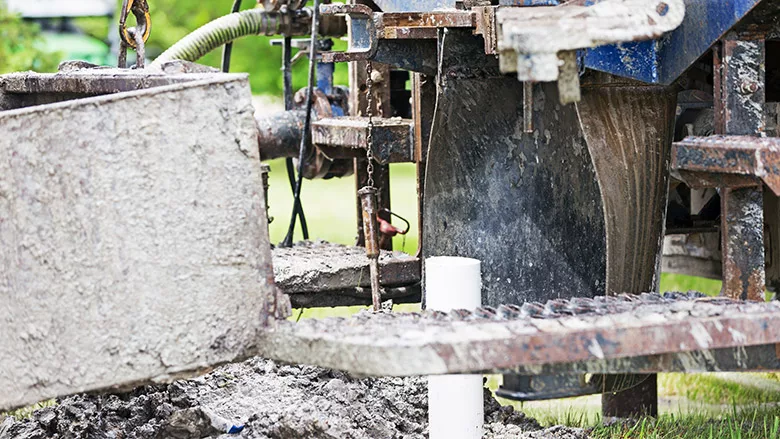Drilling in Clay, Shale and Mudstone: How do you React?
Reactive Soils Take Require a Tactical Drilling Fluids Approach

Reactive soils are kind of inevitable for drillers, but how they handle those soils can make all the difference.
Source: Getty Images
Many drillers will tell you that the hardest ground to drill is reactive: oil-like clay, shale and mudstone. Swelling issues can cause you to lose the pipe you pull back, or your drill string and tools.
Swelling clays create too much hydrostatic pressure downhole and can cause frackouts or blow-outs. A loss of returns to the surface gives you the telltale sign of a problem. The primary issue? Most clays lie dormant just waiting for someone to offer a drink of water. Add drilling fluids and the party is on! As a driller you need to understand the conditions, risks and available solutions. The proper drilling fluids mix can proactively counter these aggressive ground conditions.
First let’s talk about your basic drilling fluid; bentonite is the first thing to mix in your tank. This is needed to create a low viscosity mud — no more than 35-40s viscosity, as measured by an API Marsh funnel and cup. Remember, as you drill in clays those clays mix with your bentonite and quickly increase the density or weight of your fluids.
Watch your pumping rates. Remember that you need to move heavy cuttings out of that hole, so your calculated pumping volume will be three to five times higher than normal conditions.
Second, watch your pumping rates. Remember that you need to move heavy cuttings out of that hole, so your calculated pumping volume will be three to five times higher than normal conditions. As an example, for a 10-inch tool you would need 4.08 gallons per foot in normal conditions ((10 x 10) ÷ 24.5 = 4.08 gal./ft.) in order to move clay efficiently out of the hole. In reactive conditions, you may need to pump a minimum of 12.24 gal./ft. to a maximum of 20.4 gal./ft., or a 3:1 to 5:1 ratio over volume for normal conditions.
With the base drilling fluid ready, we now need to decide on how to deal with the clay, as bentonite only does so much alone. Clays can be reactive, swelling, and sticky. To solve for these qualities, you have several options available:
- Using a viscosifying polymer encapsulates the clay, slows down hydration and gives you lubricity. These are partially hydrolyzed polyacrylamide (PHPA) polymers and you have a few options to choose from depending on the type of drilling you do. For example, for groundwater drilling look for the NSF-60 accreditation so you comply with local regulations. In HDD applications, the NSF standard is not usually a requirement. PHPA polymers come in both liquid and dry versions. Everyone has their preference, but keep in mind that in liquid versions some manufacturers offer different concentrations of active materials, whereas the dry versions are usually 100% concentration and easily dispersible. If you use a recycling system to clean your mud, keep in mind that most “long-chain” PHPA polymers blind off screens. Check with your local distributor or manufacturer for a polymer compatible with recycling applications. That product is usually described as “low viscosity.”
- Use a clay cutter/inhibitor. (I like to call it a “disrupter.”) This type of additive disrupts the electrical charges on the surfaces of the clays to prevent them from getting a drink of water (and, thus, hydrate and swell). Keep in mind that, for the most part, these types of additives are not NSF-60 listed and not suitable for use in water well applications. Depending on the product, some are not recommended for use in recycling applications since they create ultra fines; these will pass through some of the finest meshed cleaning screens and increase mud density very quickly.
- Lastly, another product used frequently when drilling in clays is a surfactant, more commonly known as a detergent. Surfactants increase the wetting properties of a drilling fluid, which reduces bit balling and help reduce the hydration of clays, creating better dispersion of clays and shales. We often recommend surfactants or detergents for use in conjunction with PHPA polymers (described above). As with other products, not all detergents/surfactants are suitable for use in water well drilling. Some manufacturers do offer an NSF 60 certified surfactant.
All of these options offer some mix of the following characteristics:
- Reduced bit balling
- Elimination of clay and shale swelling
- Lubricity
- Increased penetration rates and returns back to the surface
- Reduced torques and pullback forces
- Promotion of settling of clays in reserve pits or cleaners
To summarize, as a driller, know that there are products out there to make your life easier, increase production, and eliminate tool loss, messy inadvertent returns and loss of circulation. Start with a good bentonite drilling fluid and make a decision on the additives based on the ground conditions. Lastly, keep in mind that the above products can all be introduced on the fly in a situation where you start drilling in sandy soils and suddenly encounter a clay seam. Just remember that you need to increase your pumping rate to move that clay out of the hole.
Keep on turning to the right and may your returns be healthy.
Looking for a reprint of this article?
From high-res PDFs to custom plaques, order your copy today!




